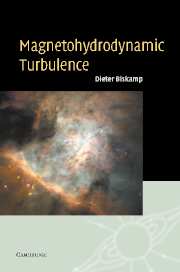Book contents
- Frontmatter
- Contents
- Preface
- 1 Introduction
- 2 Magnetohydrodynamics
- 3 Transition to turbulence
- 4 Macroscopic turbulence theory
- 5 Spectral properties and phenomenology
- 6 Two-point-closure theory
- 7 Intermittency
- 8 Two-dimensional turbulence
- 9 Compressible turbulence and turbulent convection
- 10 Turbulence in the solar wind
- 11 Turbulence in accretion disks
- 12 Interstellar turbulence
- Outlook
- References
- Index
10 - Turbulence in the solar wind
Published online by Cambridge University Press: 17 August 2009
- Frontmatter
- Contents
- Preface
- 1 Introduction
- 2 Magnetohydrodynamics
- 3 Transition to turbulence
- 4 Macroscopic turbulence theory
- 5 Spectral properties and phenomenology
- 6 Two-point-closure theory
- 7 Intermittency
- 8 Two-dimensional turbulence
- 9 Compressible turbulence and turbulent convection
- 10 Turbulence in the solar wind
- 11 Turbulence in accretion disks
- 12 Interstellar turbulence
- Outlook
- References
- Index
Summary
The solar wind provides an almost ideal laboratory for studying high-Reynolds-number MHD turbulence. Turbulence is free to evolve unconstrained and unperturbed by in situ diagnostics, satellite-mounted magnetometers, probes and particle detectors. We will see that many features of homogeneous MHD turbulence discussed in the previous chapters are discovered in solar-wind turbulence, but there are also unexpected and still unexplained features. Since the turbulence varies significantly in the different regions of interplanetary space depending on the local solar-wind conditions, it is useful to first give at least a rough picture of the mean solar-wind properties, before discussing the properties of the turbulent fluctuations about the mean state.
Mean properties of the solar wind
Stars lose not only energy by radiation but also mass (and angular momentum) by a, more or less, continuous radial flow called the stellar wind, the solar wind in the case of the Sun. The origin of this flow is the high temperature in the corona, which means that the coronal plasma is not gravitationally bound and, if it is not confined by magnetic loops, expands into interplanetary space, giving rise to the supersonic solar wind. The flow extends radially out to a distance beyond the planetary system, before it is slowed down by the termination shock expected at roughly 100 AU (1 AU ≃ 1.5 × 108 km is the Earth's orbital radius). It thus forms a bubble in interstellar space, the heliosphere. The solar-wind plasma consisting of fully ionized hydrogen with a small admixture of helium soon reaches supersonic and super-Alfvénic speeds.
- Type
- Chapter
- Information
- Magnetohydrodynamic Turbulence , pp. 217 - 232Publisher: Cambridge University PressPrint publication year: 2003



